Rare and unique items from the Archives and Special Collections at the University of Strathclyde.
Don't wanna be here? Send us removal request.
Link
We have moved! Please click on the link above to visit our new blogging home where you can continue to enjoy stories from the Archives and Special Collections at the University of Strathclyde. Please note this blog on Tumblr will no longer be updated.
0 notes
Text
How the College of Speech Therapists got its name and how it became the Royal College of Speech and Language Therapists
Dr Linda Armstrong, our Speech and Language Therapy friend, was on the trail to discover where the Royal College of Speech and Language Therapists got its name. We thought it fitting to share this post today, 6th January, as this was the official inauguration date (in 1945) of the, then named, College of Speech Therapists!
Two organisations amalgamated in the first half of the 1940s to become the College of Speech Therapists (CST). The process was protracted, not least because it happened mostly during the second world war. I’ve outlined the story of how the British Society of Speech Therapists and the Association of Speech Therapists (previously the Remedial Section of the Association of Teachers of Speech and Drama) came together in ‘Stop-go - how the College of Speech Therapists was formed’ (PDF).
It hadn’t been all that long before then that ‘speech therapist’ had become the accepted title for the profession. In the first 30 years of the twentieth century, there was a wide range of job titles used. For example, Cortlandt MacMahon went by instructor in voice production, instructor for speech defects (and breathing exercises) and speech specialist among other titles. In 1911, his was the first UK hospital speech therapy clinic (in St Bartholomew’s Hospital, London). That variety of job titles reflects the quickly developing state of the profession at the time as well as his interests and focus. ‘Speech’ is prominent among the job title names he used as are ‘voice’ and ‘instructor’ (but not therapist).

I’ve looked into the history of the name of the profession and the professional body: ‘Changing name of the profession and the professional body’. Notable dates include:

But that hasn’t explained the choice of ‘College of Speech Therapists’ as the name of the professional body that was formed from a society and an association. I’ve known for some time that this was attributed to Dr Leopold Stein – it was mentioned in the 1995 history of the professional body. He was an Austrian doctor and speech therapist who emigrated to the UK in 1938. He very quickly established himself as a leader in UK speech therapy and became a CST Founder Fellow (with Professor Jois Stansfield).
Much more recently, I came across contemporary evidence in the 1942 meeting minutes of the Remedial Section of the Association of Teachers of Speech and Drama (now looked after by University of Strathclyde’s Archives and Special Collections). However I was disappointed to find that there’s not a copy of Dr Stein’s memorandum nor of the minutes from the special meeting to discuss the memorandum within the minutes book.

In the minutes of the meeting of 7 December 1942, reproduced with the permission of the Royal College of Speech and Language Therapists.
Dr Stein was centrally involved in the 1961 CST conference in Birmingham. It was an unusual conference with unusual proceedings, published as a book (but that’s another story). His paper in ‘Signs, Signals and Symbols’ mentioned his suggestion for naming the new professional body. I thought one of the references looked worth following up as possible information from the time about the name.
I tracked it down to the library of the Royal College of Physicians of Edinburgh – it was in part 2 of a paper on the growth and present state of speech therapy. I was very glad I was the only person there when I read page 141 and Dr Stein’s suggestion and argument for ‘College of Speech Therapists’ in it. Nobody was bothered by my excited screech!
‘We are here pointing to the need for a college of speech therapists on the lines of the existing ones, such as the Royal College of Physicians. This demand appears strengthened by the requirements of daily practice, the upholding of the professional standard, and the legal considerations.’ ‘On the scientific side, the facilities provided by a College, such as lectures, papers read at regular intervals, the publication pf the proceedings of scientific meeting, discussion groups for under-graduates and post-graduates, examinations … will certainly widen the scope of speech therapy, and so raise its standard.’
The new professional body certainly met those requirements, eg. Jansson lecture series; College refresher courses; Speech therapy CPD 1935-1965 (with Professor Jois Stansfield); College conferences; FCST by thesis 1949-1988.
I was delighted to uncover contemporary evidence for the naming of the College of Speech Therapists. Another piece placed in the UK speech therapy history jigsaw. Now, the original 1944 College of Speech Therapists’ Articles…where are they I wonder?
With thanks to Estela Dukan, Assistant Librarian at the Royal College of Physicians of Edinburgh for facilitating my access to Dr Stein’s paper. Thanks too to Professor Jois Stansfield for the copy of Signs, Signals and Symbols as well as more generally for long-standing and ongoing collaboration in researching UK speech therapy history.
#Speech Therapy#speech therapists#guest blog#archives and special collections#university of strathclyde#20th Century#archives#College of Speech Therapists#RCSLT#StrathSLT#large
1 note
·
View note
Photo

Archives and Special Collections Annual Report 2021-2022
We are delighted to present our annual report for August 2021 to July 2022. Join us as we pause to reflect, celebrate our successes and share our progress and plans for the future.
Archives and Special Collections will be closed for the Christmas holidays from Friday 23rd December and will open again Monday 9th January.
We wish you all the best for the winter break and will see you again in 2023!
0 notes
Text
Christmas at the Tech, 1912-1963 - Part 3: Christmas Lectures for Young People
To conclude our short series of posts about Christmas activities at Strathclyde’s antecedent institution, the Royal Technical College (RTC, known from 1956 as the Royal College of Science and Technology), we look at the annual Christmas Lectures for Young People. These commenced in the 1950s, upon the suggestion of the Scottish Education Department (SED). Popular science lectures for older children were then an established feature of the Christmas season in London…
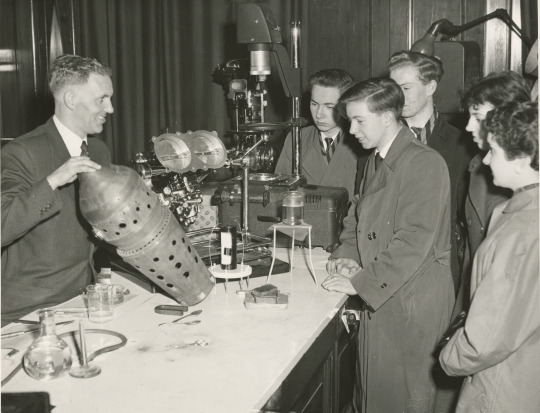
Christmas Lectures for Young People
The RTC’s annual Christmas Lectures for Young People commenced in the early 1950s, upon the suggestion of the Scottish Education Department (SED). Popular science lectures for older children were then an established feature of the Christmas season in London, and the SED, feeling that ‘Scotland was lagging behind England in this matter’, approached the Director of the RTC, Dr (later Sir) David Anderson, in 1951 with the idea of providing similar lectures for secondary school pupils in the West of Scotland.[1] Anderson responded positively, and the first Christmas Lectures for schoolchildren in Glasgow and the West of Scotland, organised by the RTC in conjunction with the SED, were delivered on 3 and 4 January 1952. The presenter, Dr Charles H. Giles of the RTC’s Department of Technical Chemistry, addressed the theme of ‘Chemistry and Colour Photography.’
Having proved successful, the lectures then became a permanent feature in the RTC calendar, taking place every December. Lectures on two different topics, delivered by separate presenters, were offered each year, with both presenters repeating their lecture a second time so that as many children as possible could attend. In session 1953-1954, external academics from the University of Edinburgh and University College, Dublin were invited to come and deliver the lectures. However, it proved so challenging for them to arrange and rehearse their practical demonstrations at the RTC in advance that, in subsequent years, the speakers were selected solely from the staff of the RTC.
The Christmas Lectures for Young People were carried on by the RTC’s successor bodies, the Royal College of Science and Technology (RCST, 1956-1964) and the University of Strathclyde (1964 onwards). While their primary purpose was to inspire and instruct children in aspects of science and technology, the lectures also served to entertain, and the presenters often chose topics that would appeal to children, such as ‘Pests and Parasites’ (1954) and the aptly named ‘Combustion – Some Burning Questions’ (1958). The photograph above shows Dr P.T. Carter, senior lecturer in the Department of Metallurgy, explaining the principles of jet and combustion engines to some of the children who heard him speak on ‘Metals in the Service of Mankind’ in December 1956 (reference: OP4/191).
[1] OE/12/12/24, Papers and correspondence relating to Christmas Lectures. Note on Christmas Lectures, c.1955.
#large#Archives and Special Collections#University of Strathclyde#EYA2022#explorearchives#Christmas#Royal Technical College#Royal College of Science and Technology#Christmas at the Tech
3 notes
·
View notes
Text
Christmas at the Tech, 1912-1963 - Part 2: Festive Editions of Student Magazines
In the second of our posts about festive activities at the Royal Technical College (RTC), or ‘the Tech’ as it was popularly known, we look at Christmas editions of student magazines.
The student Editorial Committee behind the Royal Technical College Magazine, which was renamed in session 1924-1925 as The Mask, usually incorporated seasonal stories, cartoons and other features into the Christmas edition, or featured hand-drawn, festive artwork on the front cover. An example of the latter is this caricature of the Student Union’s curmudgeonly but well-loved janitor, Bindle, in the guise of Santa. Instead of toys, Bindle’s Santa sack contains a snooker table complete with cues and balls, a chess board, cigarettes, beer, and other items from the students’ wish-list.[1]

A particular highlight of the Christmas-themed features in the magazine is a tongue-in-cheek take on the pantomime, ‘Cinderella’, which appeared in January 1913.[2] The Tech was known worldwide for the quality of its scientific and technical instruction, and practical, scientific knowledge features prominently in the students’ version of this classic story, where it is deployed to great comic effect. Cinderella’s two ugly sisters are here recast as students of the Tech, studying ‘maths and baking’ (the RTC had a thriving School of Bakery). Instead of having to cook, clean and keep house, poor Cinderella, being ‘as clever as she was good,’ is forced to do her sisters’ maths exercises for them!
On the night of the Students’ Union dance, Cinders dresses her sisters in their finery and sees them off. Left alone to watch ‘the delta signs and the sums to infinity in the flames of the kitchen fire,’ she expresses a forlorn wish to go and dance with the Union President. Cinders’ Fairy Godmother duly appears, and, by waving her magic wand over a bottle of hydrogen sulphide (H2S - a colourless gas smelling of rotten eggs), some empty cans and a broken alarm clock, conjures up ‘a beautiful new taxi’ to whisk Cinders off to the dance. Instead of providing her with a dainty pair of glass slippers, the Fairy Godmother hands over one of the sisters’ maths textbooks to serve as a dance programme, for no student could be admitted to the dance hall without a programme.
Having danced not only with the Union President, but with all the other student presidents too, Cinderella’s ‘regular swell time’ is curtailed when the clock strikes twelve, and she dashes off, leaving behind half of the maths textbook in the hands of the smitten ‘Nicest President.’ With no glass slipper to be tried on, the President conceives an ingenious way of tracking down his beloved: he announces that he will marry the girl who can solve a test exercise set by the Professor of Mathematics. Will there be a happy ending? Read on below to find out!
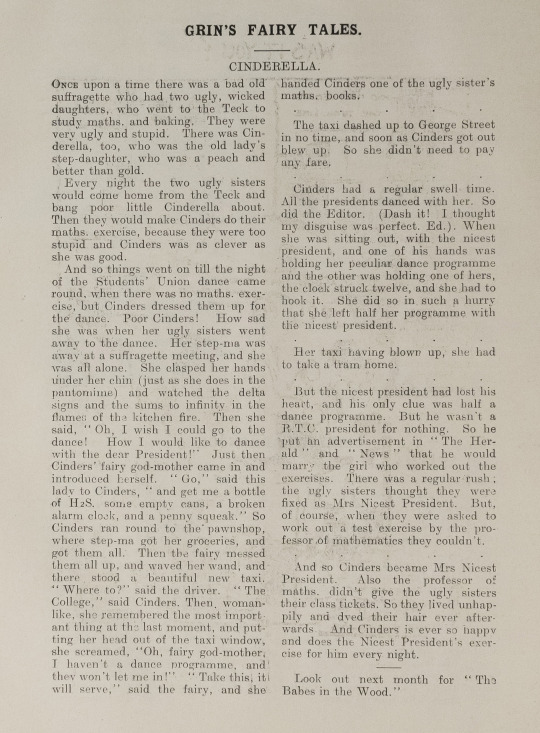
[1] OJD/1/2/61, The Mask, vol.XX, no.3, December 1935.
[2] OJD/1/1/5, The Royal Technical College Magazine, vol.5, no.4, January 1913, p.94.
#large#Archives and Special Collections#University of Strathclyde#EYA2022#explorearchives#Christmas#20th century#Royal Technical College#Royal College of Science and Technology#student magazines#Christmas at the Tech
0 notes
Text
Christmas at the Tech, 1912-1963 - Part 1: Students’ Christmas Ball and Children’s Christmas Party
With Christmas time approaching and most of Strathclyde’s students and staff back on campus following the pandemic, many in-person celebrations and festive activities are being planned for the first time in several years. This series of three blog posts looks back at some of the Christmas activities associated with Strathclyde’s antecedent institution, the Royal Technical College (RTC), renamed in 1956 as the Royal College of Science and Technology (RCST) and popularly known as ‘the Tech’. We begin by considering two of the most eagerly anticipated events of all: the students’ Christmas Ball and the Children’s Christmas Party.
Christmas Ball
Organised annually by the Students’ Representative Council (SRC), the Christmas Ball was a major event in the RTC and RCST social calendar and provided a welcome opportunity for students to let their hair down following the end of term exams. To encourage ticket sales, the SRC’s Dance Committee publicised the Ball in the student magazine, The Mask, and in the student newspaper, the Telegraph. The advertisement below was placed in the December 1938 issue of The Mask (reference: OJD/1/2/76).

The Dance Committee (later the Entertainments Committee) invested considerable time and effort to ensure the Ball’s success. In the early years, a hotel in central Glasgow would be booked to host the event: in 1926, for example, the Christmas Dance took place at the Grand Hotel, and in 1930 and 1931 the venue was the Ca’ D’Oro Ballroom. By the 1940s, however, the Christmas Ball generally took place in the RTC’s own Assembly Hall, which doubled as the Exam Hall. The new Student Union building in John Street, which was opened in 1959, later provided appropriate facilities for hosting the Ball and similar functions.
When the Ball was held on campus, the Committee had the unenviable task of decorating the hall for the occasion. In 1944, the RTC’s Navigation Department loaned them some flags for this purpose, ‘and it was [also] decided that the members of the Dance committee should look around the local shops for streamers etc’.[1] In subsequent decades, as the numbers of students studying at the RTC expanded, more resources were available and the new Union building offered increased space and scope for decorations, the Committee’s plans became more ambitious. The early 1960s saw the Christmas Ball organised according to a different theme each year, ranging from ‘Arctic Aurora’ (1960) and ‘Tropical Bally-Ho!’ (1961) to ‘Neptune’s Nocturnals’ (1962: programme pictured below, reference OJA/18/2/3) and ‘Black Friday’ (1963).
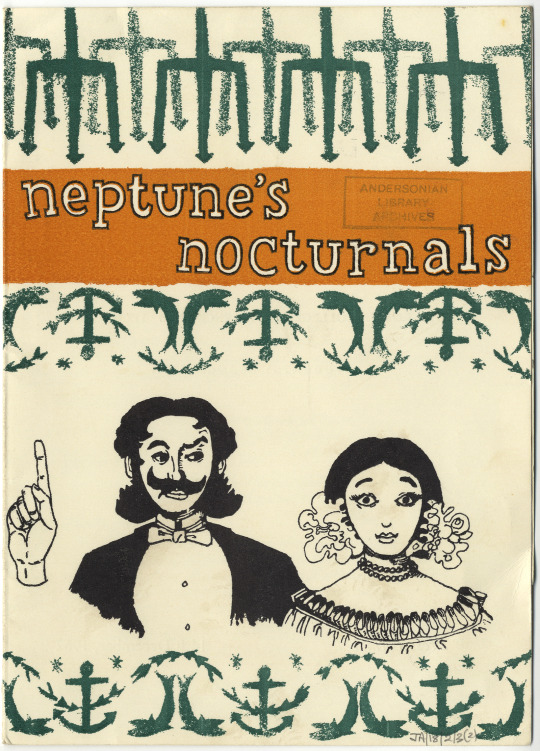
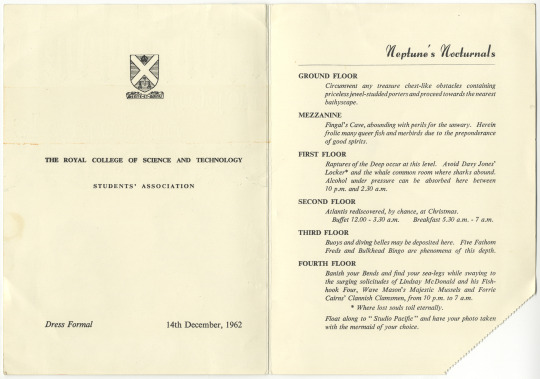
Designing and constructing props and decorations for a themed event demanded specific skills for which the Committee turned to members of the Architecture and Building Society, the RCST’s club for architecture students.[2] As the Committee minutes show, the ‘Architects’ club’ chose the theme for the Ball from a shortlist of suggestions supplied to them by the Committee, opting for that which offered the best artistic and practical possibilities.[3] As well as designing and building the set and props, the architecture students also designed the Ball tickets. Unfortunately, we have no photographs of the themed sets and decorations, but they were impressive, at least according to the writer of this letter in the student newspaper of 13 January 1961:
Dear Madam, I feel I must write an appreciation of the decorations for the Christmas Ball. The Assembly Hall and the Fourth Floor landing, were masterpieces in decoration and the spiral of tinsel down the stair well was a magnificent welcome on entering the building. The Architects who de- -signed the “set” as it were, and also everyone who helped in any way with the decorating of the building are to be congratulated on their wonderful achievements. I must, however, deplore the practice carried out at the Ball itself, of stripping the Christmas tree in the Dining Hall of its tinsel so that the female participants in the Ball might be decorated still further. Not only is this tinsel costly, but it did not greatly enhance the coiffures of the ladies who were seen wearing it. To conclude, thanks to the architects, for the splendid decorations and no thanks to those members who spoiled it slightly by ruining the Tree.[4]
The Committee’s labours did not end with decorating the hall, for one of their most important tasks was to engage a suitable band or bands for the evening. The 1950s and 1960s saw combinations of dance bands and jazz bands booked to play at the Ball; by the early 1960s, an additional ‘beat band’ was also booked to play during the interval. The Committee was further responsible for hiring caterers to provide a buffet; arranging the provision of at least one liquor bar; and organising screenings of several short films (mostly cartoons) in rooms adjacent to the main dance hall. If funds permitted, the evening’s entertainment would extend to a cabaret: a ‘Malayan fire eater’, who also performed hypnotism, was booked as the cabaret artist for the Christmas Ball in 1961.[5] Less spectacular (and less dangerous) amusements were also laid on for that year’s event, including ‘Enticing Bingo Sessions’.[6]
As the decades progressed, so too did the hour at which the Ball concluded. In the 1930s, the event tended to finish at 2.00am. In 1944, the students sought permission for the Ball to last all night, but the RTC’s Director, Sir Arthur Huddleston, was averse to the idea.[7] By the late 1950s, however, the Ball was generally scheduled to conclude at 6.00am and ‘breakfast tickets’ were available, entitling each holder to enjoy a hot meal in the early morning before making their way home.[8] In 1960, a double ticket for the Ball cost 25/ and a breakfast ticket cost 3/6d.
Annual Children’s Christmas Party
As well as a Christmas Ball for the students, the Students’ Representative Council of the RTC and RCST organised an annual Christmas party for younger children from local children’s homes, held in the Students’ Union. Transport and catering costs for this event were met from the proceeds of Wednesday lunchtime showings of Fred Quimby’s Tom and Jerry cartoons, organised by the Entertainments Committee. Each student attending the ‘Freds’, as these cartoon screenings were known, was asked to give a donation of 3d.[9]
According to this report in the student newspaper of 13 January 1961, the children’s party was a loud, frenetic, but happy occasion:
The Children’s party was held in the Union on Wednesday the 28th December. Children from homes and orphanages in Glasgow as well as the children of Union employees were given a first class treat. [To] The music played by the members of the College Music Society, the children enjoyed all their favourite singing games i.e. “The Farmer Wants a Wife”, “The Grand Old Duke of York”, and “Pass the Parcel”. The band survived although surrounded by hosts of inquisitive children who found the microphone a very intriguing gadget. Lemonade, cakes, jelly, fruit and ice cream disappeared at an alarming rate. The children had a break from balloon bursting and musical games in an excellent little film show. Then Santa, alias Ian McClure, gave them each a present before they went home.[10]
A more candid report of the same event appears in another section of the newspaper, revealing that, due to an outbreak of mumps among the younger children at one of the homes, a group of 14-year-olds had been dispatched to attend the party in place of the usual 3-8-year-olds. Unsurprisingly, ‘They did not appreciate the Farmer wants a Wife as much as usual and Santa felt perhaps just the tiniest bit embarrassed . . . by giving “Bunny Painting Books” to mature youths. Luckily they were wrapped.’[11] Despite this hiccup, the annual party was both a welcome source of diversion and entertainment for the children, and a rewarding, if physically exhausting afternoon for their student hosts.
Today, Strathclyde’s students and staff continue to bring Christmas cheer to disadvantaged children in Glasgow through the University’s annual Christmas Toy Appeal. Since its inception in 2016, the appeal has provided approximately 8,000 gifts of toys, which have been distributed to six schools and nurseries and 14 charities. Staff and students wishing to participate in this year’s appeal may hand in donations of new, unwrapped toys to the University of Strathclyde Library until 12 December. Cash donations may also be made by following this link: https://onlineshop.strath.ac.uk/product-catalogue/student-experience/widening-access/christmas-toy-appeal-2022.
[1] OJA/6/1, Students’ Representative Council Dance Committee minute book, 1941-1946: minute of meeting on 10 November 1944.
[2] OJA/6/3, Students’ Representative Council Entertainments Committee minute book, 1958-1964: minute of meeting on 24 October 1960, p.92.
[3]OJA/6/3, Students’ Representative Council Entertainments Committee minute book, 1958-1964: minute of meeting on 9 November 1962, p.214.
[4] OJD/3/1, Telegraph vol.1, no.12, 13 January 1961, p.4.
[5] OJA/6/3, Students’ Representative Council Entertainments Committee minute book, 1958-1964: minute of meeting on 9 November 1962, pp.214-216.
[6] OJD/3/2, Telegraph vol.2, no.7, 8 Dec 1961, p.1.
[7] OJA/6/1, Students’ Representative Council Dance Committee minute book, 1941-1946: minute of meeting on 10 November 1944.
[8] OJA/6/3, Students’ Representative Council Entertainments Committee minute book, 1958-1964: minute of meeting on 4 November 1958, p.8.
[9] OJD/3/1, Telegraph vol.1, no.12, 13 January 1961, p.5; OJA/6/3, Students’ Representative Council Entertainments Committee minute book, 1958-1964: minute of meeting on 4 November 1959, p.44.
[10] OJD/3/1, Telegraph vol.1, no.12, 13 January 1961, pp.3-4.
[11] OJD/3/1, Telegraph vol.1, no.12, 13 January 1961, p.5.
#large#Archives and Special Collections#University of Strathclyde#EYA2022#explorearchives#explore your archive#Christmas#20th century#Royal Technical College#Royal College of Science and Technology#Christmas at the Tech
3 notes
·
View notes
Text
Black History Month: Items sought for University Archives
This Black History Month, the Archives & Special Collections display cabinets on Level 3 of the Library are standing empty.
The cases, which can be found between the main entrance gates and new Lecture Theatre, have been left purposefully bare as an acknowledgement of the underrepresentation of diverse voices within our historical collections.

The book rests within the cases, which normally cradle precious items from the Archives, now hold just one piece of paper. It reads:
Black History Month, October 2022.
Archives & Special Collections are leaving these display cases empty as an acknowledgement of the under representation of diverse voices within our historical collections.
We are seeking to increase the visibility of historically marginalised groups in our collections by inviting donations from Strathclyde multicultural communities. We are particularly interested in the following items:
Student club and society memorabilia
Student magazines
Photographs
Student lecture notes
Course handbooks
Class year books
Records of University staff.
Collections relating to University teaching or research interests.
Anyone wishing to donate items to Archives & Special Collections should contact the team directly.
You may also want to:
go to the Archives & Special Collections homepage, or
follow Archives & Special Collections on Twitter
Library seeks to diversify its Main Collection
In addition to Archives & Special Collections' appeal, the Library has been awarded £5000 by the Strathclyde Alumni Fund for the purchase of more diverse texts for its main collection.
#Archives and Special Collections#University of Strathclyde#archives#University archives#black history month
2 notes
·
View notes
Text
Jazz on a Friday afternoon with the James Waugh Collection

This month we were privileged to have a visit from a family who donated one of our more unusual, and certainly one of our coolest, collections.
The James Waugh record collection comprises over 2,300 vinyl records of Jazz music, collated during the career of James (‘Jim’) Waugh presenter of ‘Nighthawk’ late night Jazz show on Radio Clyde in the 1980s. The extensive collection is an excellent representation of Jazz movements, styles, decades, and artists and includes some very rare records too. Find out a little more about the collection itself and collector James Waugh from our previous blog-post.
We were delighted when daughter of James Waugh, Katie, got in touch with us to arrange a visit when her family reunited in Glasgow this summer (for the graduation of sister Helen). Katie along with her Mum Genevieve (who generously gifted the collection to us in 1998), sister Helen, nephew Thomas, partner Phil and 5-month-old son William came to visit one Friday morning to see and listen to the collection and to remember and reminisce about James Waugh and his prolific activity in the Scottish art and media scene.
Baby William is named for his grandfather who was officially called William James Barrie Robb Waugh and it was particularly fitting to see baby William drift off into a relaxed and mellow mood (was that some little toes tapping?) to the sounds of Thelonius Monk, Charlie Mingus, Miles Davis & co.
The Archives and Special Collections team found out fascinating stories about some of the records, including Tommy Smith’s ‘Giant Strides’. Genevieve and Jim were responsible for the cover art for this record which turns out to be a long exposure photograph of a bridge over the M8 in Glasgow! Genevieve explained that what looks like the blurred keys and body of a saxophone caught in motion are actually the lights over the motorway which can be made out when the image is turned 90 degrees to the right.

Particularly poignant sounds of the day were "Song for My Father" by the Horace Silver Quintet and Weather Report's "Birdland" which Genevieve had made special request to hear played once more on Jim's own vinyl.
Katie let us know how what spending the morning with the collection meant to her: “This was such a special visit for me. My father died when I was just 11 so I have very limited memories of him... to be able to listen to and touch some of his records made me feel that much closer to his memory. I'm so glad that over 20 years later people are still enjoying his collection.”

Katie and Ella (photograph reproduced with permission from Katie Bennett)
The archives team greatly enjoyed the visit too. It was fantastic to meet with the family who donated this fascinating collection and to find out a bit more about the man behind the discs, who was also something of a gifted musician himself. What could be better, on a Friday morning, than some great Jazz and lovely company, including a most adorable baby?

Genevieve, Katie and Helen in 1998 (photograph reproduced with permission from Katie Bennett)
#jazz#records#vinyl#20th century#special collections#James Waugh#Nighthawk#album art#music#archives and special collections#university of strathclyde#deposited collections
1 note
·
View note
Text
International Women’s Day 2022: Miss Janet Gallie (1888-1953), Mistress of Method at the Glasgow Provincial Training College
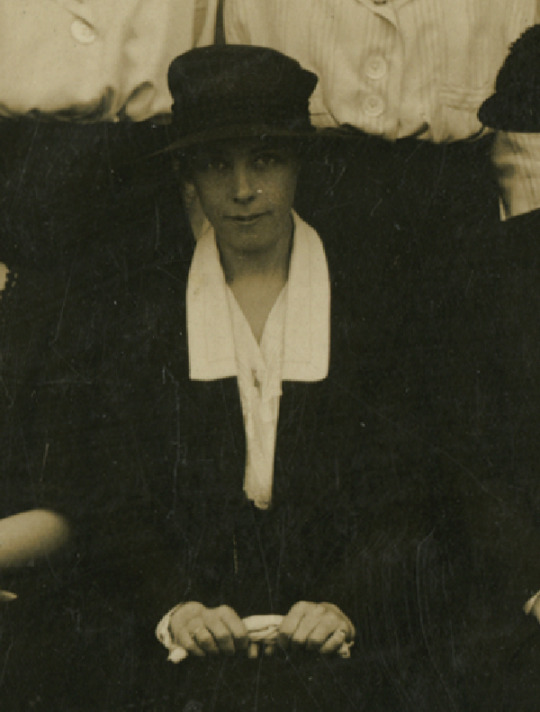
Janet Gallie (ref: JCE/22/1/7)
Held annually on 8 March, International Women’s Day celebrates the cultural, political, and socioeconomic achievements of women around the world. To mark International Women’s Day 2022, this post traces the career of Miss Janet Gallie, who lectured for over 30 years at the Glasgow Provincial Training College, antecedent of the University of Strathclyde, and helped to train hundreds of women to work as primary school teachers throughout Glasgow, Scotland and beyond.
Janet Buchanan Gallie was born in Glasgow on 27 May 1888, to James Gallie and Margaret Jane Gallie, née Buchanan. She had three younger siblings: James junior, born in 1890; Dorothy Jane Loudon, born c.1894; and Agnes Margaret, born in 1901. The 1901 Census shows the family residing at ‘Kilwinnet’, a nine-roomed dwelling house located at 25 Sutherland Avenue in Glasgow. The household also included one live-in domestic servant, and two temporary servants: a Monthly Nurse and a Mother’s Help, Margaret Gallie having given birth to her youngest child, Agnes, less than a month previously. The family still lived at the same address a decade later, when the 1911 Census was taken.1
After leaving school, Janet studied for the degree of Master of Arts at the University of Glasgow. She graduated, aged 21, in October 1909, having secured the required passes in Latin, Mathematics, French, Logic, English, Botany and Natural Philosophy.2 She then followed her father into the teaching profession, being the only one of the four Gallie children to do so.3 In the autumn of 1909, Janet enrolled for a one-year professional training course for graduates (‘Course D’) at the Glasgow Provincial Training College, which was managed by the Glasgow Provincial Committee for the Training of Teachers. While most of her fellow trainees received help from the authorities to cover their tuition fees and living expenses, Janet’s father paid her training fee of £10. 0s. 0d. and she sought no maintenance allowance (the contemporary equivalent of a student grant).4 This suggests that the Gallies’ financial circumstances were reasonably comfortable. Indeed, James Gallie was a long-established employee of the Glasgow Provincial Training College, where his post as Lecturer in Music (Singing) carried a maximum salary of £500 per annum.5
During her training year, Janet performed particularly well in the following subjects: Methods and Practice of Teaching, in which she was graded ‘Very Good’; School and Personal Hygiene (‘Very Good’); Psychology (‘Very Good’); Drawing (‘Very Good’) and Singing (‘Excellent’). She completed the course successfully and was recognised as a Certificated Teacher from 1 August 1910. As well as gaining the General Certificate, which was the basic qualification to teach in elementary schools, she received endorsement as a teacher of Drawing in terms of Article 37b.6
After qualifying, Janet worked for short periods of time at several elementary schools managed by the Govan Parish School Board, including Govanhill Public School, Church Street Primary School, Pollokshields Public School and Calder Street Public School. She was then appointed as a permanent Assistant Teacher at Stow Practising School from 26 November 1911, at a salary of £30 per annum.7 Stow Practising School was one of the two demonstration schools then associated with the Glasgow Provincial Committee for the Training of Teachers, where the Glasgow Provincial Training College students came to observe and to practice giving lessons.
In December 1915, the Glasgow Provincial Training College had need of an additional member of staff to help instruct its students in Methods. The Provincial Committee proposed to transfer Helen Gray, one of Janet’s fellow Assistants at Stow Practising School, to the Methods Department of the Training College for the remainder of the session, but Miss Gray was unable to take up the secondment, which was offered to Janet instead. She accepted, and her temporary transfer took effect on 11 January 1916.8 Janet’s arrival to join her father, James Gallie on the staff of the Glasgow Provincial Training College may have been some comfort during a difficult period that lay ahead for the family, as Janet’s 15-year-old sister, Agnes, sadly died later that year.
Perhaps owing to the protracted nature of the First World War and its impact on the College, Janet’s secondment lasted longer than originally intended. She was still a temporary member of the College staff in September 1917, when, extra assistance then being required for the teaching of Phonetics, she was directed to ‘give special attention to the methods of teaching Reading, especially in relation to the work of the students in Phonetics.’9 Finally, in September 1919, a permanent vacancy arose within the Methods Department, and it was recommended that ‘Miss Janet B. Gallie be placed on the permanent staff of the Methods Department in connection with the Training College students.’ As Mistress of Methods, her starting salary was £250 per annum, rising by increments of £15 to a maximum of £350.10
Mistress of Methods
The Methods Department served to instruct students in the general theory and practice of teaching and was one of the key departments of the Glasgow Provincial Training College. Trainees knew that achieving a final grade of ‘Very Good’ in Methods could considerably improve their employment prospects: as the College magazine, The New Dominie put it, ‘the teaching mark plays such an important part in the immediate future of the student.’11
In Methods lectures, the students learned how to convey information effectively to children; to make judicious use of the blackboard, maps, pictures, and other visual aids to hold pupils’ attention, and, crucially, to maintain discipline in the classroom. They also learned that correct speech and good deportment were vital attributes for an aspiring teacher, and were instructed to enunciate properly - eschewing the characteristic West of Scotland glottal stop - and adjust their pitch and tone of voice appropriately; to convey confidence and authority in their physical appearance (head held high, good eye contact, and no folded arms or hands in pockets when addressing a class); and to be punctual, methodical, orderly, and thorough at all times.
The Methods staff, including Janet Gallie, were all required to be experienced schoolteachers themselves. In addition to lecturing, their duties included giving demonstration lessons to classes of children in the Practising Schools, observed by the students. The page below, from the notebook of trainee teacher Florence Adams, records a demonstration lesson about Mary, Queen of Scots, given by Miss Gallie at Dundas Vale Practising School on 12 November 1919.12
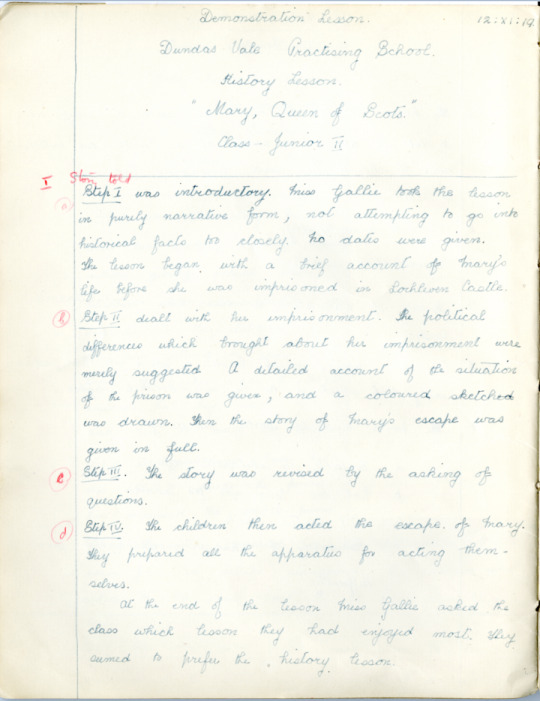
Methods classes also involved criticism lessons, or ‘crits’, in which the students put their learning into practice and tested out their classroom skills. They took turns to plan, prepare, and teach a lesson to a class of children, while the Methods lecturer and their fellow students looked on, judging the positive and negative aspects of their performance. The lecturer not only assessed the student delivering the lesson, but also marked their peers’ written observations on the content of the lesson and the appearance, speech, and attitude of the presenter.13
Within the Methods Department, Miss Gallie was one of several staff responsible for the training of the female ‘non-graduate’ students, who followed a two-year (or from 1931, a three-year) course to qualify as primary school teachers. She appears to have been genuinely liked and respected by her students, who poked gentle fun at Miss Gallie’s demonstration lessons on poetry in the College magazine:
miss gallie / went to the palais / her feet move to rhythm / so she teaches pomes wythm14
Unfortunately, Miss Gallie’s extensive duties, involving a continuous round of lecturing, demonstrations, and ‘crit’ assessments, may have exacerbated underlying health conditions, for her career was punctuated by several prolonged spells of illness. Significant health issues first arose in 1922, a year after the Glasgow Provincial Training College relocated to a new, purpose-built campus at Jordanhill. In September 1922, Janet’s father wrote to the Glasgow Provincial Committee’s Sub-Committee on Studies, ‘intimating that Miss Gallie was suffering from a nervous breakdown and asking that, in the circumstances, she be granted six months’ leave of absence’. The Committee acceded to this request.15 Another extended absence followed several years later, stretching from 7 January 1938 until the beginning of February 1939. On this occasion, Janet was welcomed back to the College with palpable relief, the New Dominie reporting that ‘It is a pleasure to record the return of Miss Gallie after a long and trying illness. Colleagues and Students alike join in wishing her well.’16
Senior Methods Lecturer
By the early 1940s, Miss Gallie was the senior Methods Lecturer within the department, having accumulated 28 years of dedicated service to the Glasgow Provincial Training College. In January 1944, the Principal Master of Method and head of the Methods Department, Mr Eric Eaglesham, was promoted to the post of Depute Director of Studies at the College. The Glasgow Provincial Committee decided that, until a new Principal Master could be appointed, Mr Eaglesham would retain control of the Methods Department, but would receive assistance from Miss Gallie in visiting and assessing students who were out on teaching placements in various schools around the West of Scotland. To enable her to take on this responsibility, Miss Gallie was relieved of some of her own duties with the first-year non-graduate students, which were assumed by a temporary Assistant Mistress of Methods.17
Up until this point, the post of Principal Master of Method had always been held by a man. The Glasgow Provincial Committee, whose members included two women, now wanted to make the position available to candidates of both sexes; but its wishes were overruled by its superior body, the Central Executive Committee, who determined that the role be reserved for male applicants.18 The post was accordingly advertised as open to men only, which prompted protests from the Glasgow Association of University Women and the Joint Body of Women Teachers’ Organisations.19 Henry P. Wood was subsequently appointed as Principal Master of Method from 1 October 1944, at which time Miss Gallie returned to her normal duties.20 In seeking to open the post up to women, had the Glasgow Provincial Committee perhaps hoped to promote an existing female member of the College staff, such as Miss Gallie? While it is tempting to speculate, the answer will never be known for sure.
Two years later, in session 1946-47, Henry P. Wood achieved promotion to Depute Director of Studies and the position of Principal Master of Method again became vacant. Miss Gallie was once more called upon to assume ‘advisory duties’, thus freeing Mr Wood to devote most of his time to his new position until a successor could be appointed. In recognition of this, the Glasgow Provincial Committee awarded Miss Gallie an honorarium of £15; however, it may have seemed scant consolation when the post of Principal Master of Method, still a male preserve, remained unattainable to her.21 It is also likely that the additional responsibilities she had shouldered further affected Miss Gallie’s health, for she was absent from the College on medical certificate from 11 February to 9 March 1947.22
Despite her ongoing health difficulties, Miss Gallie was clearly a capable lecturer and teacher with vast experience of the workings of the Methods Department. To have twice taken on higher responsibilities when the post of Principal Lecturer lay vacant, and yet be excluded from applying for it herself, must have proved incredibly frustrating. In 1948, Miss Gallie composed a letter to the Glasgow Provincial Committee on behalf of her female colleagues, requesting that the position of Principal Lecturer in Methods, and the posts of Director and Deputy Director of Studies, Principal Lecturer in Education and Principal Lecturer in Psychology, which were also restricted to men, should be available to women.23 Just as in 1944, the Glasgow Provincial Committee was sympathetic to this idea, and forwarded Miss Gallie’s request to the Central Executive Committee ‘for favourable consideration’. Unfortunately, the Central Executive Committee, which was composed entirely of men, chose to do nothing.24
Miss Gallie’s health continued to decline thereafter, and she was absent again from 1 October 1949.25 She did not return to work that session, and on 1 May 1950, the Sub-Committee on Studies considered her request to retire from the College at the end of the month. With regret, the Committee acceded to her wishes, ‘and the Director of Studies was asked to inform Miss Gallie accordingly, and to express the Committee’s appreciation of her long and valued service.’26 The cumulative effects of chronic illness, an extensive and intensive workload, and, one suspects, disappointment at the lack of opportunity for further career progression, had taken their toll. Miss Gallie’s departure, and the significant contribution she had made to the life and work of the College and its students, was duly acknowledged in the Summer 1950 issue of the New Dominie:
Many teachers throughout Scotland will learn with regret that Miss Janet B. Gallie is leaving us at this time for health reasons. Her retiral brings to an end a family association with the College which goes back for many years, for her father was a Lecturer in Music, while Miss Gallie herself has been a member of the Methods Staff for over thirty years. An able teacher, a sound and independent thinker on educational matters, and above it all, a woman of wide culture, Miss Gallie has left the impress of her personality on many who have long left Jordanhill. She will be greatly missed in the Schools of the West of Glasgow by Headmasters, Staffs, and children alike, and we all hope that she will be long spared to enjoy the rest and leisure she has so richly deserved.27
Having retired to Aberfoyle in Perthshire, Janet Gallie succumbed to coronary thrombosis and diabetes on 7 May 1953, two years after leaving the College.28 Even though her attempt to open up senior posts within the Glasgow Provincial Training College to women did not succeed, she had instructed, moulded, and exerted a positive influence upon hundreds of trainee teachers throughout her 34 year career, and deserves to be remembered as one of College’s most dedicated and long-serving members of staff.
[1] 1901 Census of Scotland, 644/14 30/ 5, page 5 of 16; 1911 Census of Scotland, 644/18 25/ 20, page 20 of 41, accessed via Scotlandspeople.gov.uk on 7 March 2022.
[2] JCE/10/1/1: Glasgow Provincial Training College, General register of students admitted to training, 1905-1915: women graduates trained for one year, 1909-10, p.193.
[3] James junior became a Mercantile Clerk, and Dorothy studied medicine and surgery at the University of Glasgow, graduating with the ordinary degrees of MB and ChB in 1920. 1911 Census of Scotland, 644/18 25/ 20, page 20 of 41; The Scotsman, 12 October 1920, p.6.
[4] JCE/10/1/3: Glasgow Provincial Training College, Register of candidates for admission, 1908-1919; JCE/10/1/1, p.193.
[5] JCE/1/1: Glasgow Provincial Committee for the Training of Teachers (GPCTT): Minutes of meetings, 1916-17, p.61.
[6] JCE/10/2/5: Glasgow Provincial Training College: Schedule showing results of students who completed training (form 17T), 1909-10.
[7] JCE/10/1/1, p.193; JCE/1/1: GPCTT Minutes, 1911-12, p.167.
[8] JCE/1/1: GPCTT Minutes, 1914-15, p.206; GPCTT Minutes, 1915-16, p.65.
[9] JCE/1/1: GPCTT Minutes, 1916-17, pp.61, 70.
[10] JCE/1/1: GPCTT Minutes, 1918-19, p.97.
[11] JCE/21/3/3: New Dominie, vol.XVI, no.2 (Easter 1937), p.72.
[12] JCE/22/2/23: Methods notebook of Florence Hope Adams, student at the Glasgow Provincial Training College, 1919-1921.
[13] Ibid.
[14] JCE/21/3/3: New Dominie, vol.XII, no.3 (June 1934), p.95.
[15] JCE/1/1: GPCTT Minutes, 1922, p.70.
[16] JCE/21/3/3: New Dominie, vol.XVIII, no.2 (Summer 1939), p.155; JCE/1/1: GPCTT Minutes, 1938, pp.66, 94; GPCTT Minutes, 1939, p.32.
[17] JCE/1/1, GPCTT Minutes, 1944, pp.22-23.
[18] JCE/1/1: GPCTT Minutes, 1944, p.38.
[19] JCE/1/1: GPCTT Minutes, 1944: p.80.
[20] JCE/1/1: GPCTT Minutes, 1944: p.86.
[21] JCE/1/1: GPCTT Minutes, 1947, p.2.
[22] JCE/1/1: GPCTT Minutes, 1947, p.4.
[23] M.M. Harrison and W.B. Marker, eds, Teaching the Teachers: the history of Jordanhill College of Education 1828-1993 (Edinburgh: John Donald,1996), p.44.
[24] JCE/1/1: GPCTT Minutes, 1948, p.113; Harrison and Marker, Teaching the Teachers, p.44.
[25] JCE/1/1: GPCTT Minutes, 1949, p130; GPCTT Minutes, 1950, p.35.
[26] JCE/1/1: GPCTT Minutes, 1950, p69.
[27] JCE/21/3/3: New Dominie (Summer 1950), p.22.
[28] Statutory registers, Deaths 325/ 2: Janet Buchanan Gallie, accessed via Scotlandspeople.gov.uk on 7 March 2022.
#Archives and Special Collections#University of Strathclyde#iwd2022#International Women's Day#women#archives#university archives#photograph#20th century#Glasgow Provincial Training College#Jordanhill College of Education#teacher training
5 notes
·
View notes
Text
Keith Brown and the Big Bang
The Keith Brown papers are a fascinating collection of research reports and analysis of banking in the UK and Europe from the 1970s to the 1990s. The collection documents the era of banking which saw the deregulation of the stock market in London on 27th October 1986, known as the 'Big Bang'.
Keith Brown was a partner at W. Greenwell & Co. in the period leading up to the Big Bang. During this time there was an increased requirement for a more instant response to results and company news so short reports were produced on the day the news was announced. This complemented detailed reports on individual companies and regular monthly commentaries.
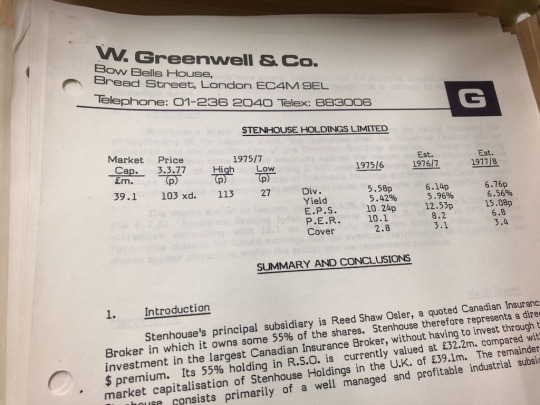
The marketing of research ideas was vital. Analysts were in demand for radio and television broadcasts and the leading analysts, such as Keith Brown, had the opportunity of projecting their views to a wider audience and therefore being more closely followed by the market.
This was an era of a huge extension of international research. The expansion of UK investment banks into the European market, with their main offices in London added an enormous competitive factor to the market. Many of the London stockbrokers were engulfed by the large banks (W. Greenwell & Co. was acquired by Midland Bank in 1987) but the real innovators were the US investment banks.
In 1988 Keith Brown joined Morgan Stanley as Managing Director to develop a pan-European bank and financial services companies product. Alongside its international analysts Morgan Stanley quickly made a name for itself in pan-European research and sales. Within two years Keith Brown's research had been developed into every banking market in Europe with coverage of the major banks in each country. The extensive reports produced initial coverage which was followed by regular commentaries. Keith Brown's research in this time was regularly rated by the industry as top in its field.
This was also the time for privatisation as capital raising for the industry and high-quality research was a major factor in selecting investment banks as advisors and bookrunners. Keith Brown's research was used to support capital raising and privatisations in Portugal, Italy, Austria, Belgium, Spain, Finland, Greece, France, Sweden, Singapore and Australia.

In 1995 Keith Brown moved from research to investment banking and for the next four years used his contacts in the industry to lead teams involving mergers and acquisitions, capital raising and privatisations in European banks.
The Big Bang was the catalyst that led to the rise of London as a leading global financial centre. Keith Brown’s career spanned this era and his research reports and analysis are a unique resource now available for research.
Keith Brown papers (BRO)
#Archives and Special Collections#university of strathclyde#archive cataloguing#archives#Keith Brown#20th century#banking
0 notes
Link
We are delighted to present our annual report for August 2020 to July 2021. Join us as we pause to reflect, celebrate our successes and share our progress and plans for the future.
0 notes
Photo

ArchI’ve Explored... Student Autograph Albums
Over the past two years, the Coronavirus pandemic and the consequent restrictions around socialising, travel and in-person meetings have caused many of us to think about, miss, and appreciate our friends more than ever. Accordingly, this post for Explore Your Archive week 2021 focuses on friendship, as expressed in three teacher training students’ autograph albums from the early twentieth century. These volumes are not autograph albums in the modern sense, as they do not contain the collected signatures of celebrities; rather, they contain inscriptions by the trainees’ fellow students, and might more appropriately be described as friendship books.
By the early 1900s, the practice of compiling autograph albums was long established, and was especially popular with school children and college and university students. Blank albums were often presented as gifts, which the recipients would then ask their friends and classmates to inscribe with verses, sketches, and other tokens. The blank albums, pictured below, were broadly similar in appearance, featuring faux leather covers with the words ‘Autographs’ or ‘Album’ in gold lettering. As their pastel-coloured pages began to fill up, however, each volume was transformed into a unique and enduring record of friendship.

The owners of the three albums considered here were all female students taking the General Certificate course to qualify as primary school teachers. The first volume belonged to Sarah McLellan (1884-1956), who studied at the Glasgow Church of Scotland Training College, also known as Dundas Vale, from 1903-1905 (reference: CSTC/7/13). The opening page of Sarah’s album is inscribed by her mother, Annie McLellan, and dated 18 January 1905. This was the date of Sarah’s 21st birthday, which suggests that her album was a birthday gift. The second album was compiled by an unidentified female student who attended the Glasgow Free Church Training College from 1906-1908 (reference: FCTC/8/9), while the third album belonged to Mary McDonald (1898-1997), who studied at the Glasgow Provincial Training College from 1917-1919 (reference: JCE/22/2/26). On the flyleaf, Mary wrote her name and address and the date: 14 July 1918. This was the date of her 20th birthday, again indicating that Mary received her album as a present.
In early twentieth-century Glasgow, hundreds of female students were admitted to teacher training courses annually. Each training college divided its new intake into several large sections, and the students then remained in their allocated section for the duration of their two-year course. The three autograph books include lists of all the students within their owners’ sections. In Sarah McLellan and Mary McDonald’s albums, a handful of those named in the section list also wrote out their full address on a separate page. Presumably, these were the girls with whom Mary and Sarah were particularly friendly, and with whom they most wanted to keep in touch.
As indicated above, most of the pages in each album bear personal inscriptions by individual students, generally in the form of verses or drawings. When invited to sign an album, a student usually selected a page for herself, filled it up and added her signature or initials at the bottom, usually with the date. More rarely, she might contribute two or more pages to the same volume, like Mary McDonald’s classmate, Jenny Bonar, who penned at least three sets of sketches for Mary’s album. The most thoughtful and detailed inscriptions probably came from the compilers’ closest friends. However, when the contributors’ signatures and initials are compared against the names in the section lists, it is apparent that many of the compilers’ classmates contributed nothing at all. For instance, only 14 of the 80 students within Mary McDonald’s section provided an illustration or a literary contribution for her album. Mary had likely approached her classmates selectively, as it would have been practically impossible to circulate the album to every member of such a large group.
The dates appended to each contribution show that Sarah McLellan, Mary McDonald and the third, unidentified compiler each began the process of collecting autographs from their classmates well in advance of finishing their studies. This was essential, as every person they invited to contribute would need time for inspiration to strike, then a further period to perfect their inscription or illustration before returning the book, to be passed to the next person. Sarah McLellan obtained her blank album in January 1905 and was due to finish her training in July of that year; we know that her classmates were contributing to the album by March 1905, if not a little earlier. Mary McDonald received her album in July 1918 and was due to complete her training course in July 1919. Her classmates were signing the album’s pages by August 1918. The unidentified owner of the remaining album started her training in 1906 and completed it in July 1908. Although we do not know exactly when she acquired her book, her classmates were adding content by September 1907.
Many of the students’ contributions are small watercolours, or sketches executed in pencil and ink. Delicate flower studies, landscapes and seascapes feature prominently, as well as portraits and some illustrations of animals and birds. Several examples are shown below.
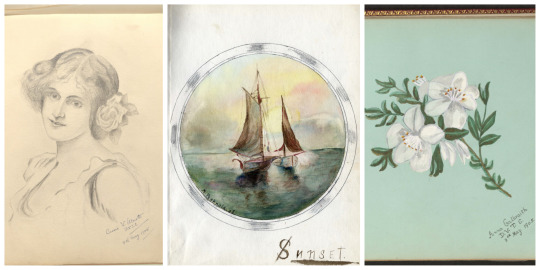
References: CSTC/7/13, FCTC/8/9
The quality of these images reflects the fact that the trainee teachers’ curriculum included both drawing and nature study. Many of them were skilled in the former subject, obtaining endorsements as teachers of drawing in addition to their general teaching qualification.
Several sketches in the albums take the form of boats sailing into the sunset, signifying the end of girlhood, of training, and of the students’ time together. Other contributions draw upon topics covered in the students’ training course or make more overt reference to their college experience. One of Sarah McLellan’s fellow students, for instance, reproduced the words and melody of ‘The Normal Call,’ which was the Church of Scotland Training College song, while this drawing by Mary McDonald’s classmate, Victoria Gaul, pokes fun at the psychology classes that were part of the General Certificate curriculum:

Reference: JCE/22/2/6
In keeping with the sentimental purpose of the albums, some students copied out carefully chosen verses by Burns and other authors. These either praised the compiler’s personal qualities or entreated her to think of, and remember, the contributor. Other students expressed hopes for the compiler’s future happiness and good fortune, especially in the pursuit of love and marriage. A highlight of this type is the beautifully executed ‘map of matrimony’ drawn by Annie S. MacKenzie in 1907. Plotting the course of courtship, the map guides Annie’s friend and classmate from the starting point of ‘spinster isles’ and ‘bachelor cove’ down through the ‘strait of flirtation’ and the ‘gulf of matrimony’, with the journey culminating at the ‘region of rejoicing’.
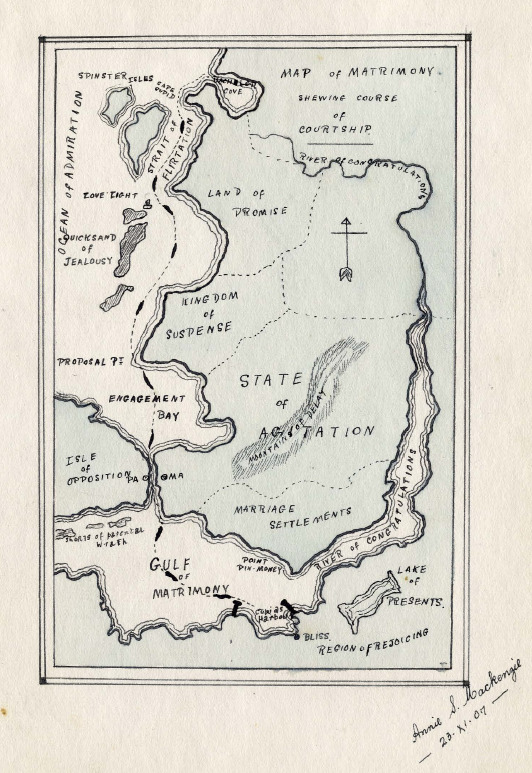
Reference: FCTC/8/9
Yet not all female students aspired to matrimony: another contributor to the same album, Marion Burleigh, urged the compiler to ‘gather gear by every wile . . . for the glorious privilege / Of being independent.’ Humour also characterised many students’ contributions. This tongue-in-cheek illustration by Sarah McLellan’s classmate, Jane G. Martin, imagines a future suitor striving to win Sarah’s hand:

Reference: CSTC/7/13
As it turned out, Sarah did not marry and apparently continued teaching until her retirement.
Perhaps the most charming and creative contribution is the ‘Casket of Gems’ provided by another of Sarah McLellan’s classmates, Janie P. Young. Topped with a bow displaying the initials ‘DVTC’ [Dundas Vale Training College] and ‘1903-1905’, Sarah’s dates of attendance there, the casket contains all that she, or any young Edwardian woman would require to succeed in life. This includes the cure for worry (‘laughter’), the cure for love (‘marriage’), and the cure for heartache (‘sympathy’); the best rouge (‘early rising’), the elixir of life (‘love’), and the balm of all ills (‘essence of tu-lips’); as well as the cure for laziness (‘work’), the balm of life (‘contentment’) and a stimulating tonic (‘courtship’). Each gem is revealed by lifting the small, square cut-out flaps of the casket.

Reference: CSTC/7/13
After gaining their General Certificate, most of the students who signed the autograph albums were posted to schools in and around Glasgow. Living and working within a convenient distance of each other may have helped them to stay in touch with former classmates when they left college. Two of the girls from Mary McDonald’s section inscribed her album in December 1919 and February 1920, some months after they qualified in July 1919, indicating that the friendships forged at college endured and that Mary saw her two classmates again after concluding her studies. In fact, Mary’s section went on to hold annual reunions for 60 years after they qualified, and it is tempting to speculate that she took her autograph book along on these occasions, to share and reminisce with those who had become lifelong friends.
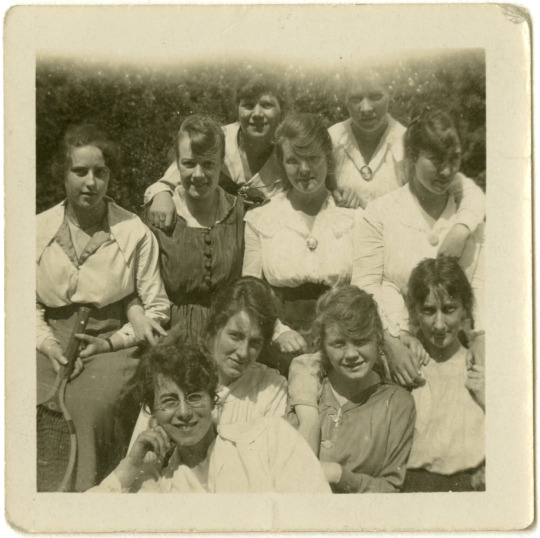
Mary McDonald (pictured in the second row, second from left) and fellow students, 1919 (reference: JCE/22/2/26).
Sarah McLellan, Mary McDonald and the unidentified owner of the third volume all continued to collect inscriptions and illustrations in their albums after completing their training. They also invited and received contributions from family and friends outside of their student circle, but the autographs of their classmates form the nucleus of each collection. These unique and beautiful volumes, cherished by their owners throughout their lives, are now preserved in the Archives as evidence of the trainee teachers’ artistic talent, their sense of humour, and, perhaps above all, their friendship and regard for one another.
#archives and special collections#university of strathclyde#explore your archive#EYA2021#women#education#archives#illustrations#20th century#jordanhill college of education#Glasgow Church of Scotland Training College#Glasgow Free Church Training College#Glasgow Provincial Committee for the Training of Teachers#glasgow
2 notes
·
View notes
Text
Dr Hugh Lang, plantation families, and the legacies of Scottish participation in Danish St. Croix
Jennifer Gray, our research intern, shares this final, fascinating instalment of her series of three blog-posts about Hugh Lang.
In 1814, Lucretia Burke was emancipated by her owner, Joseph Blake Chabert. Seventeen years later, in 1831, Burke and her four children were recorded on the ‘Free Coloured Census’ of St. Croix as living at 60 Queens Street, Christiansted.1 Her five? children—Ann Eliza, Margaret Francess, Adriana, Isabella Dorothea and Janette Adelberta—and a sixth? boy—Willy, who died young—were fathered by Dr Hugh Lang of Mansfield House in Largs, Scotland. Dr Lang’s sustained relationship with Lucretia Burke provides further evidence of the multifaceted legacies of Scottish participation in Danish St. Croix. Historians including Christine Walker and Marisa J. Fuentes have recently studied gendered power dynamics in plantation societies in the British Caribbean.2 The Lang Papers, held at the University of Strathclyde Archives and Special Collections, aid in analysing the nature of such dynamics in the Danish Caribbean, specifically Lang’s relationship with his children in later life. The collection also provides an insight into Lang’s family in Scotland and the material legacy of proceeds generated from slaveholding estates.
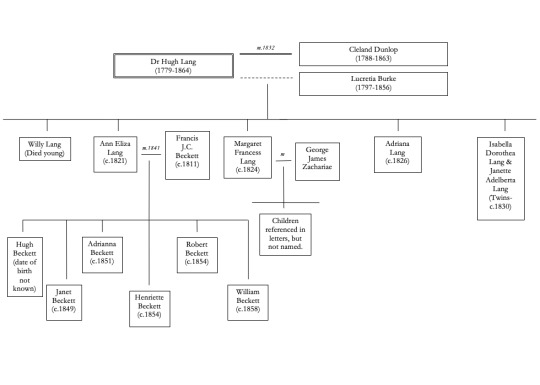
Illustration of Dr Hugh Lang’s descendants. Drawn by the author.
Dr Hugh Lang and Lucretia Burke had six children together over an estimated period of ten to fifteen years following her emancipation.3 During this period, the pair fostered a relationship that crossed racial boundaries in a planter society characterised by racial subjugation and enslavement. However, the limits of this relationship were evident in 1831, when Lang returned to Scotland and married a local Scottish woman, Cleland Dunlop, the following year; he had no further children.4 There is no indication that Dr Lang and Lucretia continued their relationship thereafter. Almost thirty years later, letters written by his eldest daughter, Ann Eliza Beckett, between 1860 and 1862, and preserved in the Lang Papers, provide an insight into Lang’s relationship with his children and subsequently, his legacy in St. Croix.
The Lang Papers provide the opportunity to analyse the ways in which free or freed children of white planters and formerly enslaved persons were forced to assimilate into plantation society and, in this case, accept the proceeds generated by their ancestor’s enslavement. In April 1860, Ann wrote to Dr Lang to request that he pay for repairs that needed to be made to her home.5 In July of that year, M. Melchior – a business associate in Copenhagen- referred to a quarterly allowance that Dr Lang paid to his youngest daughter Janette, presumably as she was not yet married.6 At his death, Dr Lang left 80,000 Rigsdaler to each of his children.7 Each of these instances demonstrates the transfer of Lang’s wealth, which was rooted in the former exploitation of enslaved labour prior to Danish abolition (1848), to his children whose mother had been formerly enslaved. It is crucial to recognise that each of Lang’s children, particularly Ann who had been widowed and was the mother of six children, would have faced discrimination due to their African heritage and despite their European heritage. Their integration into planter or European society, as far as was possible, presented the best means of survival.

The signature of Ann Eliza Beckett. T-LA/18.
Ann Eliza Lang married Francis J.C. Beckett – who was born in Guadeloupe- in 1841 and they had six children together.8 By February 1860, when the first letter of Ann’s appears in the Lang Papers, she was widowed and her eldest son Hugh was living with her brother-in-law, Dr George James Zachariae, in Copenhagen.9 The 1860 Danish West Indies census recorded Ann living at what was previously her mother’s address, 60 Queens Street, with five of her children, an elderly widow, two servants and a nurse. One of the servants, Felicia Burke, shared Ann’s mother’s surname and so it is possible she was a relative of Ann’s.10 At the time of the census, Ann was the only Lang child left in St. Croix, as her sister Margaret had married and moved to Copenhagen, taking with her Adriana and Janette, Lang’s youngest daughters. Due to the absence of reference to Isabella—Janette’s twin sister—in the Lang Papers and subsequent research, it appears likely that she had died at some point in the mid-nineteenth century.
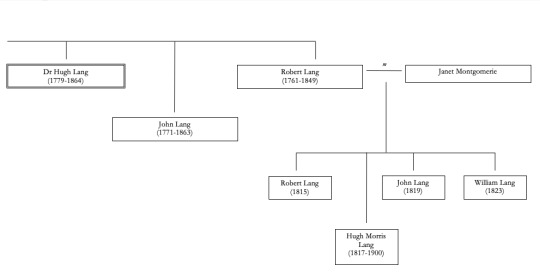
Illustration of Dr Hugh Lang’s descendants in Scotland. Drawn by the author.
While revealing the intimate details of the relationship between Dr Lang and his eldest daughter Ann, the Lang Papers additionally provide information on Lang’s family based in Scotland. In my previous blog, I discussed Dr Lang’s inheritance of his brother Robert Lang’s estates in St. Croix, where the family exploited enslaved labour. The proceeds of this exploitation continued to filter through the generations of the Lang family when he appointed his nephews, Hugh Morris Lang and William Lang, alongside two other men, as the primary inheritors of his estate.11 Upon his death in 1864, Dr Lang’s personal estate alone was valued at £168,669.19.10, equal to nearly £10 million today.12 This was notwithstanding the addition of stocks, shares, and bonds, which more than doubled Dr Lang’s fortune.13 Like his uncle, Hugh Morris Lang obtained a medical degree from the University of Glasgow in 1838, after which he practised in Largs where he also owned lands.14 The Lang Papers highlight that prior to Dr Lang’s death, Hugh Morris Lang was involved in the sale of the estate William in St. Croix in 1862 and gave instruction to Mr W. Peebles –who managed the St. Croix estates- to accept an offer of $20,500 for the property.15 This confirms Hugh Morris Lang’s role in selling off the Lang family’s estates in Danish St. Croix, profiting through the sale of the estates when they no longer proved as profitable following the abolition of slavery. As one of the primary inheritors of Dr Lang’s estate, Hugh Morris Lang was listed as the proprietor of Mansfield House—Lang’s Largs-based estate—on the Valuation Rolls of 1885.16 However, in April 1887, Hugh Morris Lang was taken to court by Clydesdale Bank Ltd. for failing to repay a sizeable debt of £4,000; Mansfield House was seized as payment.17
The Lang Papers reveal intricate details about Dr Lang’s descendants, all of whom were innately tied to slavery in St. Croix. The five children Dr Lang fathered with Lucretia Burke were indicative of the divergent and complicated nature of gender and race relations in colonial and plantation societies. Their assimilation into colonial and European society reveals the far-reaching legacy of Scottish participation in the Danish Caribbean. Moreover, the vast inheritance bestowed upon Hugh Morris Lang and William Lang illuminates the generational wealth procured from participation in Caribbean slavery. Dr Lang’s will reveals the extent to which these proceeds penetrated nineteenth-century British capitalist society, as he held shares in Clydesdale Bank Ltd., the North British Railway Company and the Edinburgh and Glasgow Railway Company, among multiple others.18 With all of this to consider, the Lang Papers are a crucial resource in analysing the human and material legacy of the Lang family’s involvement with enslavement and plantation society in Danish St. Croix, as well as offering one indicative case study of the legacies of sustained Scottish involvement in plantation and enslavement beyond the British Caribbean.
1 Svend E. Holsoe, ‘Virgin Island Families: Lang’ https://studylib.net/doc/6778043/lang---virgin-islands-families. (Consulted 20 July 2021).
2 Christine Walker, Jamaica Ladies: Female Slaveholders and the Creation of Britain’s Atlantic Empire (Omohundro Institute of Early American History and Culture, Williamsburg and University of North Carolina Press, Chapel Hill, 2020). Marisa J. Fuentes, Dispossessed Lives: Enslaved Women, Violence, and the Archive (University of Pennsylvania Press, Philadelphia, 2016)
3 Svend E. Holsoe, ‘Virgin Island Families: Lang’ https://studylib.net/doc/6778043/lang---virgin-islands-families. (Consulted 20 July 2021).
4 Church registers - Old Parish Registers Banns and marriages https://www.scotlandspeople.gov.uk/ (Consulted 10 August 2021).
5 University of Strathclyde Archives and Special Collections, The Lang Papers, T-LA/4.
6 University of Strathclyde Archives and Special Collections, The Lang Papers, T-LA/33.
7 Svend E. Holsoe, ‘Virgin Island Families: Lang’ https://studylib.net/doc/6778043/lang---virgin-islands-families. (Consulted 20 July 2021).
8 Ibid.
9 University of Strathclyde Archives and Special Collections, The Lang Papers, T-LA/4.
10. Danish National Archives, West Indian Census 1860, St. Croix Christiansted. https://www.sa.dk/ao-soegesider/en/billedviser?epid=17318984#216103,40861218. (Consulted 12 August 2021).
11 Legal records - Wills and Testaments https://www.scotlandspeople.gov.uk (Consulted 13 August 2021).
12 The National Archives Currency Converter: 1270-2017. https://www.nationalarchives.gov.uk/currency-converter/. (Consulted 20 July 2021).
13 Legal records - Wills and Testaments https://www.scotlandspeople.gov.uk (Consulted 13 August 2021).
14 Hugh Morris Lang, The University of Glasgow Story. https://universitystory.gla.ac.uk/biography/?id=WH12809&type=P. (Consulted 13 August 2021).
15 University of Strathclyde Archives and Special Collections, The Lang Papers, T-LA/94.
16 Valuation rolls https://www.scotlandspeople.gov.uk/ (Consulted 10 August 2021).
17 National Records of Scotland [NRS] CS46/1887/5/44: Decree of poinding of ground and for payment of expenses, The Clydesdale Bank Ltd v Hugh Lang and another.
18 Legal records - Wills and Testaments https://www.scotlandspeople.gov.uk (Consulted 13 August 2021).
#archives and special collections#university of strathclyde#Student Placement#slavery#hugh lang#19th century#archives#correspondence
1 note
·
View note
Text
The Lang Papers: Dr Hugh Lang and slavery in the Danish West Indies
Jennifer Gray, our research intern, shares some more of her research into Hugh Lang in this second of a series of three blog-posts.
The Lang Papers, held at the University of Strathclyde Archives and Special Collections, aid in exposing the Lang family’s enslavement of black peoples in St. Croix in the Danish West Indies. Although abolition of slavery occurred in the Danish Caribbean in 1849, ‘slave lists’ for the estates Adventure and Paradise – which the Lang family owned or part-owned - from 1818 and 1835 illustrate that the Lang family’s fortune was rooted in the exploitation of enslaved persons. These lists are available online through the Danish National Archives. Furthermore, details given in the Lang Papers highlight the significant labour shortage experienced in the decades following Danish emancipation and the ways in which the white planter community attempted to overcome the labour deficit.
The 1818 ‘slave list’ for the estate Adventure named Robert Lang, Dr Hugh Lang’s brother, as the co-proprietor of the estate, alongside a Mr. McCormack. According to the list, which can viewed here, 90 individuals of African descent were enslaved on the estate. Categorised by age and trade, the list confirms the Lang family’s registered ownership and exploitation of enslaved persons.1 Furthermore, the 1835 records for the estate Adventure, which can be viewed here, reveal an expansion of this ownership, with a total of 165 men, women, and children listed as being enslaved there. This highlights that prior to Danish abolition, the Lang family’s participation in slavery was increasing. The disregard shown toward the humanity of enslaved individuals is depicted by descriptions of their ‘moral character’, which included acute judgements such as ‘stupid’ and ‘insolent’. Moreover, the records group enslaved labourers by their place in the gang system, a particularly merciless structure of labour management that was utilised throughout the slave-holding West Indies.2
A similar pattern of increasing ownership of enslaved persons is apparent for the estate Paradise in 1818 and 1835. Crucially, the 1818 record, which can be viewed here, reveals that Dr Hugh Lang was residing on the estate.3 This is significant as it confirms Lang’s place of residence in St. Croix in 1818 and portrays his close association with his brother’s estates. Living on a working sugar plantation, it is certain that Lang actively observed and overseen the enslavement and violent treatment of black peoples in the plantation. Although the ‘slave lists’ do not feature the remainder of Dr Lang’s estates, William, Mon Bijou and Good Hope, discussed in the Lang Papers, it is highly probable that enslaved labour was also exploited on these plantations. An 1862 valuation of Dr Lang’s estate, William, within the Lang Papers, recorded a village previously utilised to house enslaved labourers, which consisted of 80 rooms.4 The probability of multiple enslaved families living in each residence testifies to the number of persons who were likely enslaved at William prior to Danish abolition and provides further evidence of Dr Lang’s intrinsic involvement in the enslavement of Black peoples. Robert Lang died in Largs on 30 July 1849 and appointed Dr Lang ‘factor or manager of the whole properties’ in his possession.5 They became two of at least five estates in Lang’s portfolio by 1860.
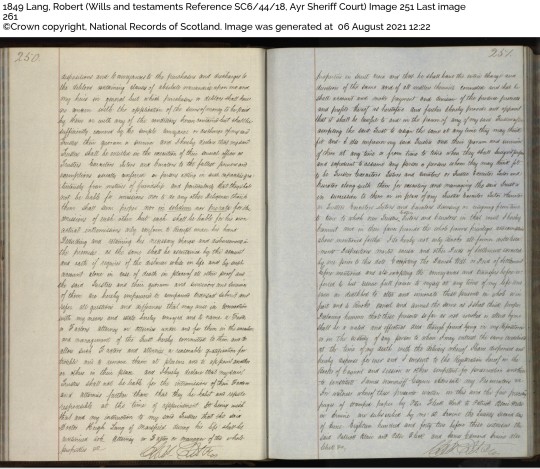
Robert Lang’s Will and his instruction regarding Dr Hugh Lang
The Lang Papers also highlight the severe labour shortage in St. Croix in the decades following the Danish abolition in 1849. The first reference to issues relating to a dwindling labour force are made in April 1861 in a letter to Dr Lang from Mr. Peebles, who managed Lang’s estates in St. Croix after Dr Lang had returned to Scotland in 1831. He advised that, at the estate, William, they supported seven labourers who were unable to work and a number of children who were too young to work in the fields or as tradespeople.6 Widespread protest from planters was subsequently reported by Peebles in June of the same year, when at a meeting of the Burgh Council, a member threatened to break through the current labour regulations if the government would not aid the bringing of indentured labourers to St. Croix. Furthermore, he ‘at the same time said that not less than 5,000 labourers would have the desired effect’.7 The crippling effects of the labour shortage on sugar production and the subsequent profitability of plantation ownership were reported in another letter in the collection. In February 1862, Mr James McFarlane reported to Dr Lang that ‘since the emancipation here the island has delivered fully one third less sugar in the ten years after than before’.8 Evidently, the emancipation of St. Croix’s enslaved population thirteen years earlier had significantly reduced the profitability of the colony’s plantations as they could no longer exploit unwaged enslaved labour. Replacing this labour force with an alternative source of low-wage labour became a prime concern for St. Croix planters.
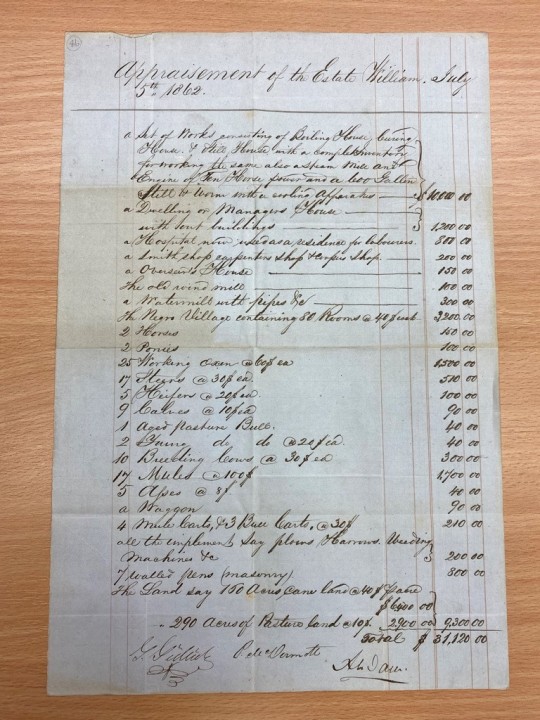
Valuation of the Estate William. (T-LA/86).
Lang and other planters’ resolution to resolve the labour shortage is revealed in letters at the latter end of the collection, where Mr. Peebles discusses ‘Coolie immigration’.9 This derogatory term refers to the coerced importation of indentured labourers from Asia, particularly China and India, who were brought to the West Indies and Americas to labour in the plantations previously worked by enslaved persons. This was another form of brutal racial exploitation, where Asian labourers lived and worked in poor conditions under a harsh labour regime for which they received very low wages. 10 Dr Lang’s engagement in the trade highlights that following Danish emancipation, planters went on to target Asian labourers and exploit them as another form of inexpensive labour.
It is imperative to highlight the Lang Papers links to transatlantic slavery and redefine what was previously known about Dr Hugh Lang. Although he lived an affluent life and died a wealthy and respected gentleman, his personal fortune and that of his family was generated through the enslavement and exploitation of African and African-descended labourers in Danish St. Croix. Crucially, as the Lang family’s estates were in the Danish Caribbean, their active participation in slavery continued for sixteen years after the British Slavery Abolition Act in 1833. This highlights the necessity of looking beyond solely the British empire when considering the role and legacies of Scottish involvement in the transatlantic slave trade and plantation economy. The legacy of Dr Lang’s involvement in Danish slavery will be touched on in my next blog, where I will discuss Lang’s family and descendants.
1 Danish National Archives, West Indian Government, Subject Files: Land Tax Register Forms for Plantations. https://www.sa.dk/aosoegesider/en/billedviser?epid=17241563#209939,39589945. (Consulted Friday 6 August 2021).
2 Danish National Archives, West Indian Government, Subject Files: Land Tax Register Forms for Plantations. https://www.sa.dk/ao-soegesider/en/billedviser?epid=17241563#209940,39590300. (Consulted Friday 6 August 2021).
3 Danish National Archives, West Indian Government, Subject Files: Land Tax Register Forms for Plantations. https://www.sa.dk/ao-soegesider/en/billedviser?epid=17241563#209940,39590327. (Consulted Friday 6 August 2021).
4 University of Strathclyde Archives and Special Collections, The Lang Papers, T-LA/86.
5 Legal Records- Will and Testaments. https://www.scotlandspeople.gov.uk/ (Consulted Friday 6 August 2021).
6 University of Strathclyde Archives and Special Collections, The Lang Papers, T-LA/17.
7 University of Strathclyde Archives and Special Collections, The Lang Papers, T-LA/30.
8 University of Strathclyde Archives and Special Collections, The Lang Papers, T-LA/74.
9 University of Strathclyde Archives and Special Collections, The Lang Papers, T-LA/85.
10 M.H. Jung, ‘Outlawing “Coolies”: Race, Nation, and Empire in the Age of Emancipation’, American Quarterly, 57:3 (2005), p.677-701.
#archives and special collections#university of strathclyde#student placement#slavery#sugar plantations#Danish West Indies#st croix#hugh lang#19th century#archives#correspondence
2 notes
·
View notes
Link
We are delighted to share the new online catalogue for the Sir Patrick Geddes Archives at the University of Edinburgh.
The collection of Patrick Geddes Archives at the University of Edinburgh was catalogued as part of a collaborative project with the University of Strathclyde Archives, which was generously funded by the Wellcome Research Resource-fund.
You can search the Patrick Geddes papers at Strathclyde on our own online catalogue.
#patrick geddes#university of strathclyde#University of Edinburgh#wellcome trust#Cataloguing#archives
0 notes
Text
New source guide: researching clubs and societies in the student magazine
This years’ history placement with Archives and Special Collections looked a little different due to ongoing Covid-19 conditions. Nevertheless, we were able to welcome Ryan O'Connor, Masters student in Historical Studies at the University of Strathclyde, as a remote student placement. He used digitised versions of the Royal Technical College student magazine (collection reference OJD/1) to explore the history of various student clubs and societies at the institution. You can read his fascinating Student clubs and societies source guide, and find out from him about his placement, below!

College Types from The Glasgow Technical College Magazine, volume 1 no. 5, February 1909 p121; volume 1 no. 3 December 1908, p62; volume 1 no. 1, October 1908, p34
This was my first course related work placement, and I found it very enjoyable and satisfying. I had not used source material from the archives before and so this placement gave me the opportunity to do so and I feel as though this has helped me become a more well rounded historian, improving my research skills in particular. I had not considered the history of the university much in my time studying here and I was pleasantly surprised to discover all the amazing and interesting information contained within the old student magazines. Through this placement I was able to not only complete a source guide on the clubs and societies of the university, I was also able to learn about the history of my university, and the students of the past who have walked down the same corridors as me, 100 years ago.
As well as finding out information related to my source guide in particular, I also came across many other tid bits in the student magazines which made the placement even more enjoyable. One example that springs to mind was in an early magazine from around 1908/1909 in which the problem of “promiscuous cuddling” in the hallways between students was reported: janitors were sent out to police the hallways! Small stories like these and many others made this placement a joy.

Illustration from The Royal Technical College Magazine, volume 12 no. 6, March 1928
Aside from improving myself as a historian and the laughs I had while conducting this research, being given the opportunity to work alongside staff from the university archives was also a great experience. With weekly meetings in which I would be given all the help and support I needed, I was always confident that the source guide would be a success. In addition, forming a working relationship with the archives staff created an environment in which I always felt I was working alongside the Archives to produce a high quality guide. The collaborative working was a pleasant change from my usual coursework. I was also able to be more open and honest with the necessary gaps in this research, as this is useful information to share with other researchers, which was also a welcome change from my standard coursework.
Overall, this placement was an amazing opportunity which I am extremely pleased I took part in. From start to finish, it was always fun and enjoyable and I feel as though I have improved myself as a researcher and historian in so many ways.
#student placement#archives#archives and special collections#20th century#university archives#students#source guide#student clubs
2 notes
·
View notes
Text
Papers of Hugh Lang, plantation owner
We are delighted to present a guest blog post from Jennifer, currently doing a research internship here in Archives and Special Collections.
Hi everyone! My name is Jennifer Gray and I’m a University of Strathclyde History graduate and intern with Research Interns @ Strathclyde. This is an introduction to my project analysing the Hugh Lang Papers, a collection held by the University of Strathclyde Archives and Special Collections. The collection consists of 94 letters, which were written between 1860 and 1862. Each letter is addressed to Dr Hugh Lang, who resided in Mansfield House in Largs and owned five estates in Danish St. Croix, where prior to Danish abolition, he exploited enslaved persons.

Portrait of Hugh Lang (1779-1864) 1
Written by a variety of authors, the letters discuss the management of the estates Mon Bijou, Good Hope, William, Paradise, and Adventure. Each estate produced sugar and rum, which was sold in both St. Croix and Denmark. ‘Slave lists’ from the early nineteenth century reveal that Lang was listed as the co-owner of enslaved persons on at least one of his estates.2 Although the letters within the collection date from after Danish abolition, it is vital to highlight Lang’s ownership of enslaved persons and the ways in which his estates exploited enslaved labour. Several of the letters highlight Lang’s dependency on enslaved labour through their discussion of the difficulties of maintaining labour forces following abolition. Details on estate management, coupled with information on international markets and late-nineteenth-century plantation-based trade, illuminate the intricacies, consequences, and legacies of Scottish participation in the Danish West Indies during the nineteenth century. I will explore these key themes through a series of blog posts with the aim to publicise the importance and potential of the Lang papers. Additionally, I will be working to amend the archive catalogue to include increased detail on the content of the collection and prepare the letters for digitisation, thereby increasing their accessibility and scope for future use.
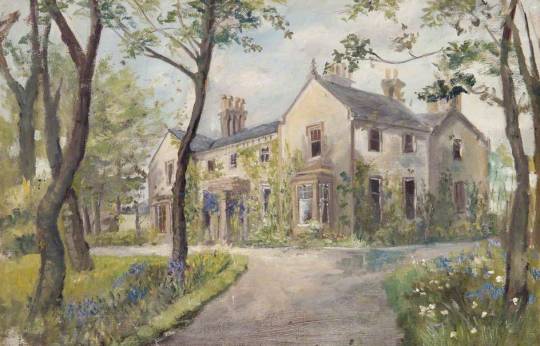
Mansfield House in Largs 3
Dr Hugh Lang was born in 1779 and obtained his medical degree from the University of Edinburgh on 24 June 1799. He subsequently received permission to practice from Copenhagen on 29 May 1800.4 Lang appears to have spent a great deal of time in St. Croix and at one time, resided on his estate Paradise. Alongside establishing a presence in sugar and rum production in the Danish colony, he formed a long-term relationship there with a formerly enslaved woman named Lucretia Burke, with whom he had six children. The last of their children, two twin girls, were born in 1830 and Lang returned to Scotland the following year, marrying Cleland Dunlop in the parish of Largs on 22 December 1832.5 Although they remained married until Lang’s death in 1864, the couple had no children. During this time, Lang remained in contact with his children in St. Croix, particularly his daughter Ann, who authored three of the letters in the collection. These letters provide a rare and important perspective into the relationship between the two and can be utilised to delve into the often complicated and diverse nature of colonial families. An analysis of this relationship and its wider significance will be carried out in a future blog post.

A 1775 map of the Virgin Islands. St. Croix circled in red 6
A significant proportion of the letters were written by Mr W. Peebles, who appears to have been Lang’s business partner, residing in St. Croix. Peebles’ letters reveal details of estate management, weather, market prices and general news from the colony. His letters can be utilised to analyse sugar and rum production on each of Lang’s estates, the markets into which the product was being sold and subsequently, the extent of Lang’s involvement in the Danish West Indies, Europe and the United States. The collection also encompasses letters from several contacts in Copenhagen, including Mr M. Melchoir, an agent of a Copenhagen merchant firm, and Mr J. Knight, a selling agent in Copenhagen. They detail the vending of St. Croix sugar and rum, exchange rates for profit generated, and also include several accounts for Lang’s estates. This provides an insight into the profitability of Lang’s business and allows for comparisons to be made between the five estates. Furthermore, the accounts illustrate the numerous charges incurred by the necessity to ship product out of St. Croix, where sugar and rum often failed to fetch satisfactory market prices. Additionally, the letters provide a commentary for wider significant historical events, such as disruption to the American market as a result of the Civil War that erupted in 1861. This provides a rare perspective of the impact of the war on Caribbean markets from the perspective of a small Danish colony.
As I continue to analyse the Lang Papers, I hope that this blog and those to follow will reveal the importance of the collection and highlight it as a resource to be utilised in future research.
1 Largs Museum Trust, A 148. https://artuk.org/discover/artworks/hugh-lang-17791864-md-208245 (Consulted 20 July 2021).
2 Danish National Archives. Land Tax Register Forms for Plantations. Plantagerne, 1835.
3 Largs Museum Trust, PCF 01. https://artuk.org/discover/artworks/mansfield-208248 (Consulted 20 July 2021).
4 Svend E. Holsoe, ‘Virgin Island Families: Lang’ https://studylib.net/doc/6778043/lang---virgin-islands-families. (Consulted 20 July 2021).
5 Church of Scotland (old parish registers) http://www.scotlandspeople.gov.uk/ (Consulted 21 July 2021).
6 David Rumsey Map Collection, List no. 4723.027. Series 46. https://www.davidrumsey.com (Consulted 21 July 2021).
#university of strathclyde#archives and special collections#guest blog#student placement#hugh lang#slavery#st. croix#danish west indies#virgin islands#archives#correspondence#19th century
3 notes
·
View notes